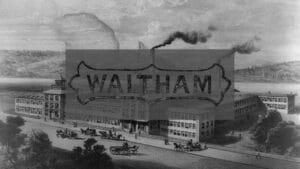Watch and Clock Repair Blog
10 Things About Waltham You (Probably) Didn’t Know
Waltham wasn’t just another watchmaker—it was one of the most influential American companies of the 19th and early 20th centuries. Known for precision, innovation, and its role in shaping modern timekeeping, Waltham helped define how the world kept time. From railroads and wartime missions to polar expeditions and aviation firsts, here are 10 meaningful things you might not know about the Waltham Watch Company.
1. They Pioneered Mass Production Before Ford
Long before the Model T hit the road, Waltham revolutionized manufacturing by applying interchangeable parts and mechanized assembly to watchmaking. Their methods reshaped industrial production globally and earned them a Grand Prize at the 1876 Centennial Exposition—decades before Ford scaled the idea for automobiles.
2. They Helped Solve America’s Railroad Crisis
In the late 1800s, deadly train collisions caused by inconsistent timekeeping led to a national reckoning. Waltham produced some of the earliest highly accurate, standardized railroad watches—laying the foundation for what became “railroad-grade” and helping prevent further disasters.
3. They Went to the North Pole
Explorer Robert Peary brought a Waltham with him on his 1909 expedition to the North Pole. In an era when explorers depended on precise navigation tools, Waltham’s reliability under extreme conditions made it the watch of choice at the edge of the known world.
4. They Timed the First U.S. Coast-to-Coast Flight
When Calbraith Perry Rodgers became the first person to fly across the U.S. in 1911, he used a Waltham watch to time his historic journey. Over 49 days and dozens of crash landings, his Waltham kept ticking—securing the brand’s place in aviation lore.
5. They Supplied the Military in Both World Wars
Waltham built wristwatches, cockpit clocks, ship chronometers, and timing devices for the U.S. military. Their products served in planes, tanks, and warships, making the brand a critical supplier during the most demanding periods of American history.
6. Their Marine Chronometers Met Naval Standards
Waltham’s marine chronometers were among the few that met U.S. Navy standards for sea navigation during WWII. These precision instruments allowed naval vessels to determine longitude with accuracy—a life-or-death capability before the satellite era.
7. They Made Aviation Instruments, Not Just Watches
Waltham wasn’t limited to the wrist. Their eight-day cockpit clocks and dashboard timers were trusted in both civilian and military aircraft. Durable and highly accurate, they were vital tools for navigation and mission timing throughout the early aviation age.
8. They Operated a Swiss Subsidiary
To reach the global market, Waltham opened a Swiss branch in the early 1900s—combining American industrial design with Swiss craftsmanship. These lesser-known Swiss Walthams are now collector favorites, blending two worlds of horology in one brand.
9. Their Watches Were Chosen by Presidents and Pioneers
Waltham’s reputation for precision and resilience made it a favorite among explorers, scientists, and U.S. presidents including Harding and Coolidge. At a time when the right timepiece could mean the difference between success and catastrophe, Waltham was a trusted name.
10. They Couldn’t Survive the Post-War Watch Wars
After WWII, Waltham faced a flood of affordable, stylish Swiss imports. With aging factories, high labor costs, and slow adaptation to market shifts, the brand couldn’t compete. The original Massachusetts plant closed in 1957, and while the name lived on under Swiss control, America’s Waltham era came to a quiet close.

